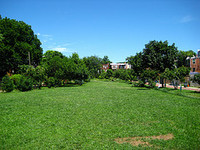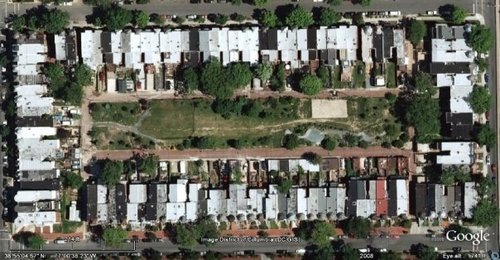Bloomingdale creates its own urban oasis

Photo of the park by rockcreek on Flickr.
A lot has been said here and elsewhere about the difficulties created for the District and its residents by federal ownership of public spaces. But let’s not forget how much ordinary citizens can do, and have done, to improve the common areas around them.
It starts in one’s own neighborhood and requires being aware of one’s surroundings, envisioning how they can be better, then working with others to see it through.
Have you ever looked at a vacant lot or other derelict, unloved space and imagined it becoming an attractive community asset? Folks in my neighborhood of Bloomingdale did just that.
Over the course of two decades, they turned 1.36 acres bounded by public alleys from an abandoned telephone switching station and cable yard into a real gem of a park. The space, which formerly attracted squatters and drug dealers is now a community-owned, volunteer-maintained urban oasis. It wasn’t easy, but despite turnover and legal battles, a tenacious band of neighbors created Crispus Attucks Park.
The park’s story, is still being written. It serves as a reminder of the tremendous impact that can be achieved by, in anthropologist Margaret Mead’s words, “a small group of thoughtful, committed citizens.”
Nestled in the alleyway behind the rowhouses bounded by North Capitol Street on the east, 1st Street NW on the west, U Street on the south and V Street on the north, the park is both a source of neighborhood pride and one of the city’s best-kept secrets. It provides hope that so many similar spaces in our city can be similarly beautified.
Addressing our society’s disconnectedness, as well as our ever-present energy and environmental challenges, will require making cities (and compact suburban and rural villages) more attractive places to live than sprawling outer-ring subdivisions. A key aspect of this is demonstrating that living in an urban environment doesn’t mean giving up access to the kinds of safe, welcoming green spaces that suburbanites take for granted.
In addition, research is beginning to demonstrate a link between the presence of greenery and reduced levels of violent crime.
Some complain that creating such spaces only hastens gentrification. But the amount of common green space available for all to enjoy shouldn’t be dictated by a neighborhood’s median income level.
Many of the Bloomingdale residents who worked to create Crispus Attucks Park were not wealthy newcomers wanting to change the neighborhood’s character; they were middle-class residents who knew they had just as much right to quality greenspace as people in leafier areas. People with limited time and means, by pooling their resources, can accomplish a lot, and by creating places for neighbors to socialize, may help to bridge the class divide that plagues the city.
The neighbor-run nonprofit that owns and manages the park is planning significant improvements.
The organization will soon present a grant proposal to the TKF Foundation to fund improvements. The grant would fund the installation of solar-paneled arbors (i.e. gazebos) in the park, and would also create additional lawn space at the eastern end. An earlier grant from TKF funded the creation of the Memory Garden in the park.
Funding from the DC government and other foundations and individuals is also being sought. Eventually, the nonprofit hopes the solar panels will power landscape lighting, an irrigation system, and a fountain while providing power back to the grid. The solar project could become a great way to educate the community about renewable energy.
As we continue to advocate policy-driven improvements to make our region a better place to live, we can’t forget the smaller parcels which can have such a large impact. It is important that we find ways to build the spaces that bring people together and allow people to find respite from life’s bustle within blocks of home.
For, as John Muir put it, “[Humanity] needs beauty as well as bread, places to play in and pray in where nature can heal and cheer and give strength to body and soul alike.”

